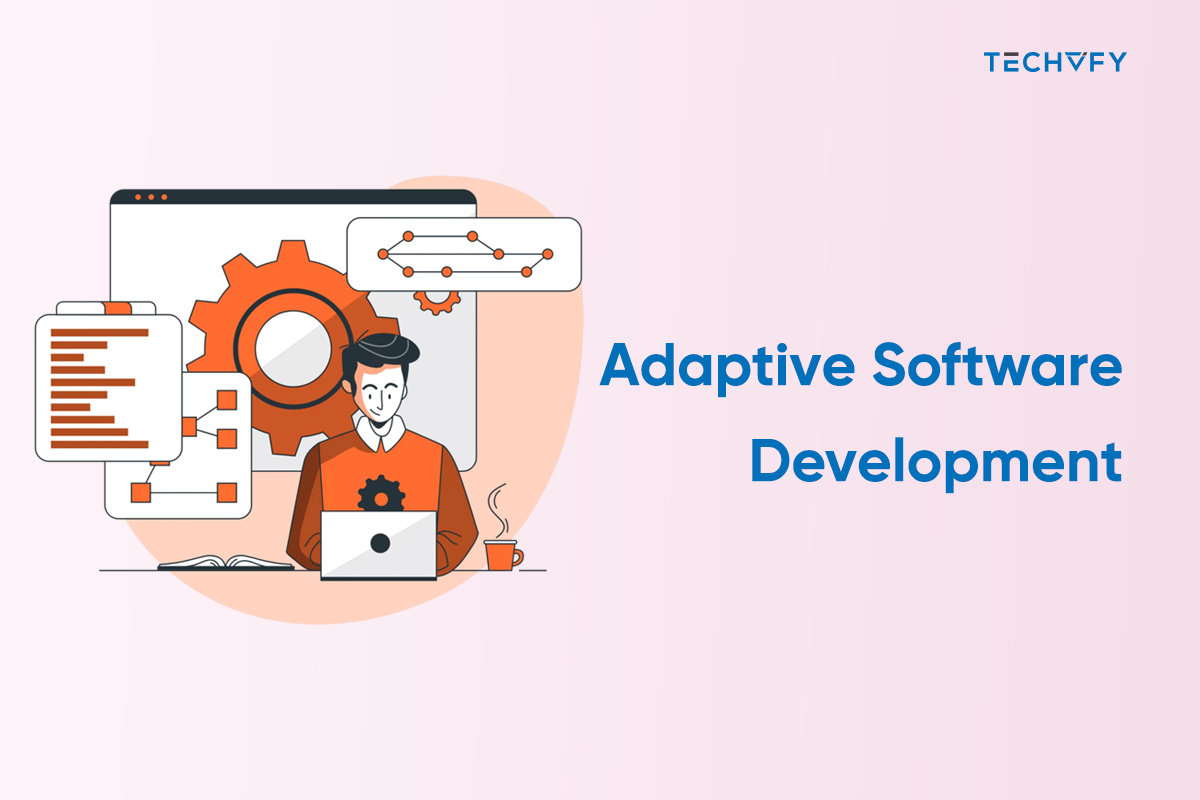MVP Development for Startups: The Most Important Strategy
- TECHVIFY Team
- 0 Comments
An MVP, or Minimum Viable Product, is well-known even outside product development. Using an MVP is a proven strategy that allows startups to introduce themselves to the public and build an audience. It also helps reduce costs and attract investors to the project.
Statistics show that up to 90% of startups fail. About 10% close within their first year, and up to 70% do not survive between their second and fifth years. The most common reasons include:
- Misunderstood or under-researched market needs (about 40%)
- Running out of budget (30%)
- Competitors who perform better (20%)
- Issues with marketing, pricing, and design (10%)
Developing an MVP is a good way for startups to avoid these pitfalls and bring their projects to success. This guide will help you understand MVP development for startups and how to build one effectively, offering insights into the MVP development process.
I. Understanding Minimum Viable Product (MVP)
The MVP, or “minimum viable product,” includes the essential features of your product to see if your idea is effective. Essentially, an MVP is a simplified version of a product or service created to test a concept or market quickly and at a low cost.
Creating an MVP aims to build something functional and appealing to users. By focusing on early successes, you can leverage these wins later during fundraising or when expanding your company.
Developing an MVP is crucial for any startup. To survive and succeed in the competitive startup space, you need an MVP with all the vital features your audience requires.
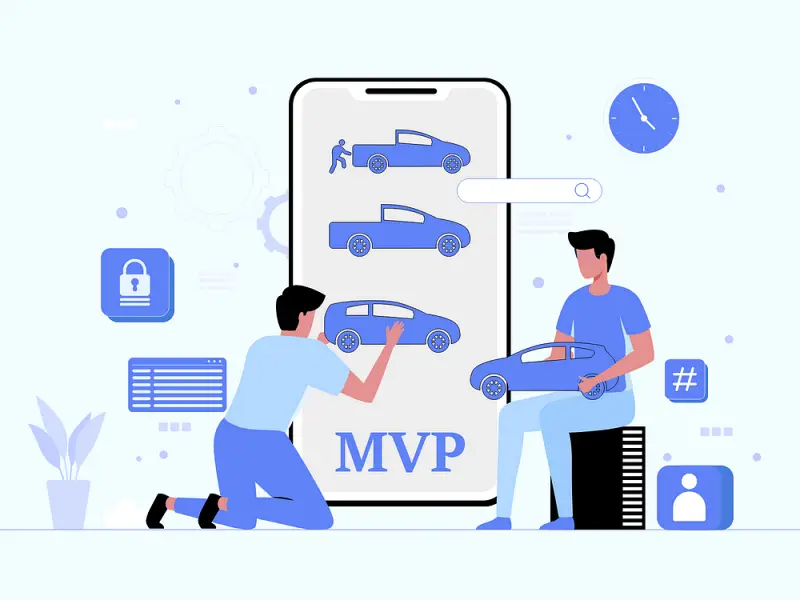
II. Why Do Startups Need a Minimum Viable Product?
Creating an MVP is a smart step for business startups uncertain about their product or service ideas. An MVP offers several valuable benefits, including:
Testing Your Idea with Real Users
An MVP lets you validate and refine your ideas before a full-scale launch. You can test assumptions by showing customers what they will get from your product. Early feedback helps you pivot quickly if something is not working, saving time and resources on features that do not resonate with customers. This process helps determine users’ fundamental requirements early on.
Minimizing Potential Risks
Launching an MVP is a low-risk way to test an idea, reducing the chance of failure. If the MVP does not succeed, the financial and time losses are generally smaller than a full project failure.
Gaining Support from Stakeholders and Investors
Businesses often need backing from stakeholders or investors to get a project off the ground. An MVP helps build confidence that the product will fulfill its intended purpose, making it easier to secure the necessary support.
Reducing Expenses
The MVP method in product development helps keep costs low and prevents the product from becoming too complex. By building a product iteratively over time, businesses can spread out the costs and reinvest revenue from earlier versions back into the product. They can make smarter investments in further development as they gain more users and gather more information.

Faster Feature Development
Our MVP development speeds up feature creation by up to two times. Most software includes standard features like authorization, media upload, content management, and payment integration. At TECHVIFY, we use an ‘assembly line’ approach with a starter development kit (SDK) and automated API technology. This increases development speed, makes the process more predictable, and reduces time-to-market.
Still want to know more about software development at TECHVIFY? Check these articles:
III. How to set up the MVP development process
The MVP development process is a crucial phase for startups. Understanding its steps and phases is key to planning a project effectively.
To develop a minimum viable product, follow these guidelines:
-
Clear Vision: Have a clear vision of what you want to achieve with your MVP. Understand your target market’s needs and desires. This will help you map out the essential features your MVP must have to succeed.
-
Find the Right Partner: Partner with a company that is enthusiastic about your project and has the necessary skills to execute it. Choose a partner with a proven track record who is committed to seeing the project through to completion.
Once these steps are complete, you can begin the development process. Here are five necessary stages for your startup MVP:
1. Idea Development
The goal of the idea development phase is to come up with a new, innovative product or service idea that can be taken to market and has the potential to succeed. This phase focuses on generating and testing new ideas to see if they have potential. Methods used include market research, customer feedback, and trend analysis.
Once a promising idea is identified, further development and testing are necessary to determine if it can be successfully brought to market. If successful, the MVP will move on to the next phase.
2. Creating a Customer Journey Map
Creating a customer journey map aims to identify and verify areas where the customer experience can be improved. Development teams use customer interviews, focus groups, and surveys to create initial versions of customer journey prototypes. This stage involves gathering information to understand your customers better. The insights gained are used to outline an action plan for future enhancements.
Here are three main steps to creating a customer journey map:
-
Define Your Goals: Determine what you aim to achieve with your MVP. Identify the problems you are trying to solve. Having a clear idea of your goals will guide you in planning how to reach them.
-
Identify User Pain Points: Understand what your users are struggling with and what they need help with. By identifying their pain points, you can think about how your product can address these issues.
-
Create a Results-Oriented Map: Focus on how your product can help users achieve their goals. Outline the steps they need to take and what they need to do to succeed. Creating a results-oriented map ensures your MVP focuses on delivering value to your users.
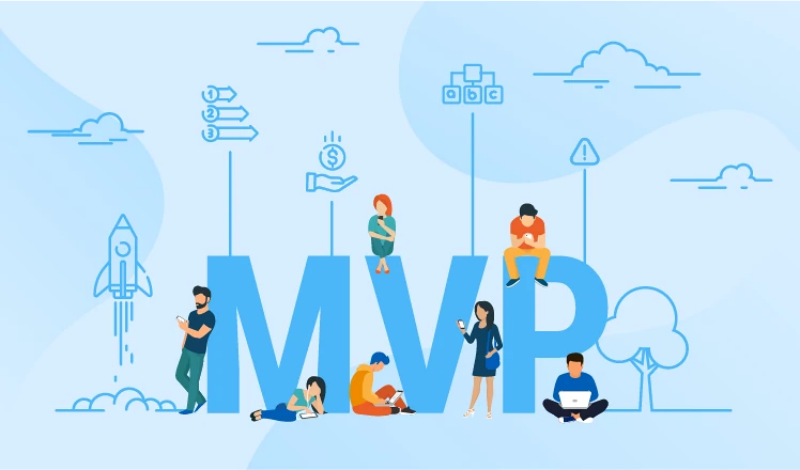
3. Prototyping Phase
The primary aim of the prototyping stage is to develop a prototype that can assess the viability of the prospective product.
The method of crafting an MVP prototype can differ based on the product type, but common steps include:
- Define the Problem and Target Market: Clearly identify the problem you are solving and your target market.
- Identify Core Features: Determine the essential features that your product must have.
- Create a Wireframe or Mockup: Develop a visual representation of your product.
- Build a Working Prototype: Construct a functional version of your product.
- Test with Potential Users: Gather feedback by testing your prototype with real users.
- Iterate Based on Feedback: Make improvements based on the feedback received.
Creating a product prototype is like a trial run. It enables you to evaluate your product and gather feedback from prospective users This step ensures that your product is usable and meets the needs of your audience. The feedback collected during this phase helps improve your product before it goes to market.
4. Implementation Phase
Product implementation involves developing a product that meets basic customer needs without adding extra features that can come later.
During this phase, focus on building your application with the minimum features necessary to test your hypothesis. This approach allows you to validate market interest in your product before investing more time and money.
This phase aims to get feedback from real customers as soon as possible. This feedback helps you make adjustments if needed. If no one wants your product after seeing it in action, it’s unlikely they will use it.
Implementing a product can be risky for companies. If not managed properly, the product may not launch successfully.
Given the high stakes, startups must take their time during product deployment. Businesses can boost their likelihood of success and avoid pitfalls by conducting thorough research and planning in advance.
5. Launch Phase
The MVP launch phase is crucial for bringing a new product to market. The objective is to confirm the product concept with real users and gather feedback for improvements before a full launch. This phase usually includes a beta test with a small group of users, followed by a broader release to a larger group. The outcome should be a product ready for full launch, with positive feedback from users.
Launching an MVP is a great way to validate an idea. If customers are willing to pay for the MVP, it indicates potential for the product.
Here are key points to remember when building an MVP:
- Affordability and Simplicity: The MVP should be inexpensive and simple to build.
- Early Feedback: Collect feedback from customers as early as possible.
- Continuous Improvement: Remember that an MVP is just the starting point. Continue to improve and iterate on the product.
By following these guidelines, you can ensure that your MVP is both effective and efficient in validating your product idea.
Looking to Outsource Development?
Contact TECHVIFY – Vietnam’s Leading Offshore Software Development & Outsourcing Company, for a consultation and development services.
IV. Challenges When Building an MVP
Unfortunately, not all MVPs succeed. Some fail for many reasons, and even small factors can have a big impact.
Building a product invariably involves overcoming roadblocks, solving problems, and facing unforeseen circumstances. Here are some common challenges and mistakes startups encounter during MVP development:
The Desire for a Perfect Product
Striving for perfection during MVP development can delay the product’s release. Your MVP should be well-balanced, well-tested, glitch-free, and attractive to users. However, spending too much time polishing the product or adding intricate features can be detrimental.
Remember, you are developing a minimal version of your future product. It makes sense to focus on the essential MVP features and let minor imperfections pass. Testing the product in the real world is ultimately more important.
Lack of Feedback
In business, generating hypotheses is inevitable, but making decisions solely based on assumptions isn’t wise. Customer experience should guide the development of an MVP for startups. Neglecting this means you may fail to meet clients’ needs. Therefore, gathering enough feedback, analyzing it, and taking action is essential. To succeed, listen to your teammates and value client feedback.
Feedback is crucial for a minimum viable product. Always keep this in mind. Encourage your clients to provide feedback: conduct research, segment your target groups, and identify their needs. The more insightful questions you ask, the better the answers you’ll receive.
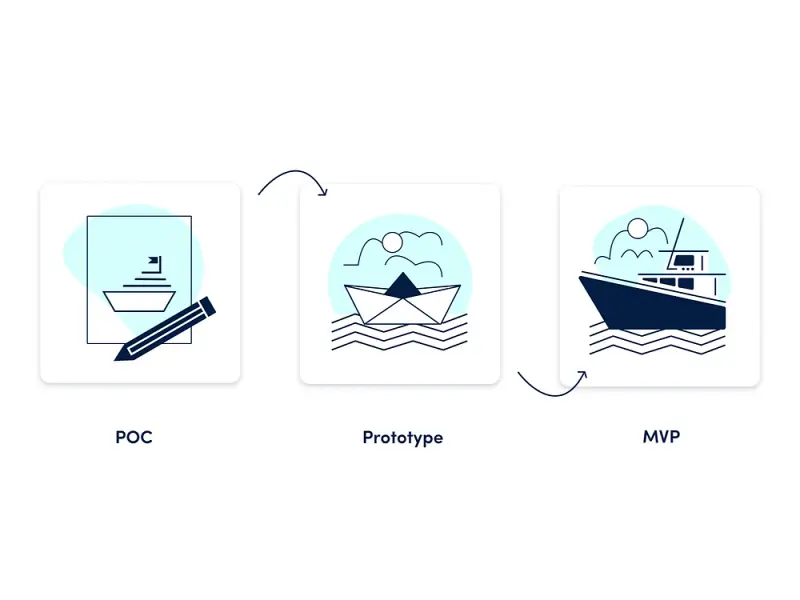
Lack of Analytics
A lack of analysis can seriously harm your product. The power of startup analytics should not be underestimated. Metrics like the number of downloads, purchases, and review sentiment provide valuable insights into clients’ opinions and the product’s market position. If these metrics indicate problems, it is crucial to take corrective action before the situation becomes irreparable.
Equally important are selecting the right set of metrics and gathering sufficient data to act on. Ensure you are not monitoring irrelevant data that might give you a false sense of security. Conversely, avoid making hasty decisions without enough information to support your conclusions.
Key Points to Remember:
- Monitor Relevant Metrics: Focus on metrics that provide actionable insights.
- Analyze Feedback Thoroughly: Use the data to understand the product’s performance and areas needing improvement.
- Avoid Impulse Decisions: Ensure adequate data justifies any changes or new directions.
By paying close attention to analytics and utilizing them effectively, you can make well-informed decisions that positively impact your MVP’s success.
Timing Errors
Timing errors can significantly impact the success of your MVP. The development process typically takes 3 to 6 months, varying by project. However, releasing too early or too late can undermine your efforts. Therefore, it’s crucial to set reasonable timelines.
Key Considerations:
- Early Releases: Launching prematurely, such as rushing a Product Hunt release without adequate preparation, can lead to long-term difficulties. Before launching, ensure that your MVP is well-tested and ready to meet your users’ basic needs.
- Late Releases: Delaying the launch too much in pursuit of perfection can also be detrimental. An MVP aims to test your hypothesis and gather feedback as soon as possible.
Best Practices:
- Balance Preparation and Speed: Aim for a balance between being well-prepared and getting your product to market quickly. Remember that an MVP should be minimal yet functional.
- Iterative Development: Use the feedback from early users to make iterative improvements. This approach allows you to refine the product based on real-world use rather than hypothetical scenarios.
Let’s talk
A consultation with the Client Relationship Manager, who represents TECHVIFY, without any commitment from your side, will give you:
- Structured and clear vision of your future application
- Information about how our software development company guarantees 100% on-time and on-budget delivery
- Recommendations for choosing the tech stack
- Advice on further steps
- Business-side recommendations
- Rough project estimation on software development
TECHVIFY is right where you need. Contact us now for further consultation:
V. Why should a startup outsource MVP development?
Outsourcing is a strategic approach to releasing new applications more quickly, efficiently, and cost-effectively. With increasing demand and rising expenses, it makes sense to consider alternatives like outsourcing. Statistics indicate that nearly 78% of organizations globally have a positive outlook on their outsourcing partners.
Outsourcing MVP development offers several advantages for startups:
Lower Development Costs
Outsourcing MVP development can significantly reduce both time and costs. Instead of building an in-house team or developing the product, you can use an outsourced team’s expertise, experience, and resources to expedite your project. This approach enables you to launch your product faster and more efficiently.
For instance, 49% of companies report that outsourcing IT operations helps them focus on core business activities by freeing up internal resources.
Accessing New Expertise
Outsourcing is a tactical method for accessing advanced technologies and specialized skills that your team may lack. For instance, outsourcing can bridge that gap if you’re developing an AI-powered platform but don’t have data scientists on staff. Approximately 46% of businesses report that outsourcing provides access to expertise that is unavailable in-house. This ensures that your product is developed using the latest best practices and standards.
Simplifying Project Management
Outsourcing can also streamline project management by providing dedicated resources from the start. You bring the concept, and the agency contributes its experience. This collaboration allows for a realistic assessment of the project’s feasibility, timeline, and deadlines. With this information, you can make informed decisions about beta testing schedules, marketing and promotion strategies, and investment approaches, knowing you have a competent technical partner.
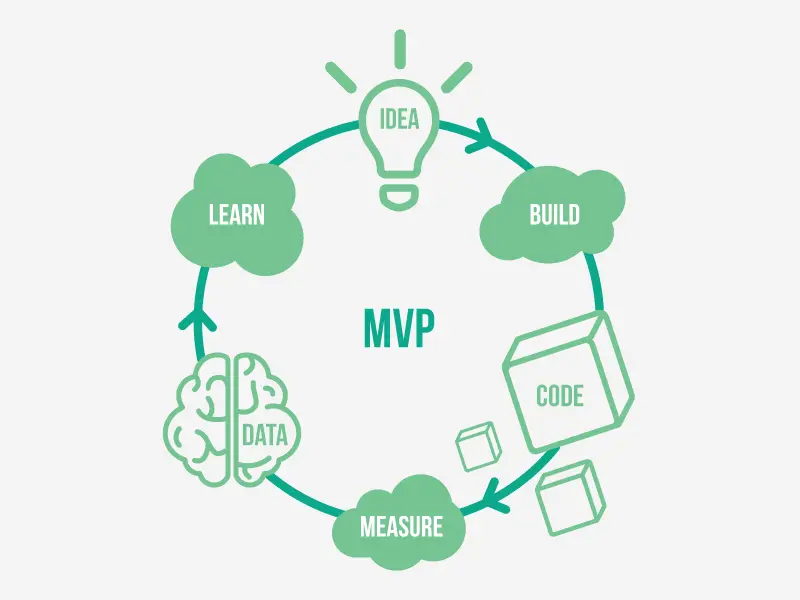
Providing Better Scaling Opportunities
Outsourcing MVP development services allows startups to scale quickly without the overhead associated with hiring new employees or paying long-term salaries before generating revenue. This flexibility is crucial, especially when revenue from the MVP might take months or even years to materialize, depending on the business model.
Ensuring Quality Responsibility
Outsourcing ensures that the final product is high-quality and meets the target market’s needs. By partnering with a reputable MVP development agency, startups can be confident that their product will be well-designed and provide a great user experience.
Learn More On:
VI. Common Misunderstandings about MVP Development for Startups
Teams may be familiar with the term MVP (Minimum Viable Product) but often misunderstand its true meaning and purpose. A common misconception is that an MVP is merely a product with the least functionality possible. However, an MVP should be functional enough to provide valuable insights about the product’s viability and the business model surrounding it. Let’s explore some common misconceptions about an MVP to avoid such misunderstandings.
It’s Not a Proof of Concept (PoC)
A Minimum Viable Product is not the same as a Proof of Concept (PoC). Typically, teams form a startup after creating a PoC to demonstrate that the available technology can address their target problem. However, making a viable product requires much more than proving the technology works.
Key Distinctions:
Proof of Concept (PoC):
- A PoC is designed to validate the feasibility of a particular approach or technology.
- It demonstrates that the technology can support the envisioned solution.
Minimum Viable Product (MVP):
- An MVP is a functional product with sufficient features to appeal to early adopters and test a business idea.
- It helps teams understand the market, segment their audience, and identify potential obstacles such as competition, customer education, financial viability, legal issues, and more.
Not a Beta Version
A Minimum Viable Product is not a Beta version of the product.
Both concepts involve customer feedback, but they serve different purposes. A Beta version is a lightly tested product given to Beta testers. Their role is to find bugs, user experience issues, and problems with stability and reliability. This task usually requires some technical knowledge.
The “Viable” in Minimum Viable Product means the product should work reliably for regular customers. These customers may not understand where the product is headed in the future. Regardless, they need a version that works well and addresses their major problem. This helps them see the product’s value and makes them willing to buy it.
Not an MMP
A Minimum Viable Product is not a Minimum Marketable Product. The MMP often comes long after the MVP. Despite this, teams sometimes over-engineer their product to meet the needs of mainstream customers right away. This approach requires much more development time and budget compared to an MVP. It leads to unnecessary waste of both money and effort. The team misses out by not releasing the product early and not getting feedback from users. They lose direction, focus, and clarity of purpose, which are crucial for success.
An MVP Must Be Viable
For a product to be viable, it needs to be something that people want, needs, and can use to solve an existing problem. It should address a problem they actively seek to solve, one that will cost them more if left unresolved. Additionally, the product must be easy to use and provide a great experience. Affordability is also crucial. A good and user-friendly product will not succeed if the target market cannot afford it.
When these considerations are met, people will show interest in the product. Feedback from demos, interviews, and trials will yield strong signals from market segments. These signals provide valuable insights into the direction of product development. This process is the most effective way to create a product that people genuinely want to use.
Conclusion
MVP development is a vital strategy for startups to validate ideas, minimize risks, and attract investors. An MVP helps avoid common pitfalls like misunderstood market needs and budget overruns by focusing on essential features and gathering early feedback. However, navigating the MVP development process requires a clear vision and the right expertise.
Transform your startup idea into a market-ready product with TECHVIFY. Our expert team provides top-tier MVP development services for startups to ensure your success. Don’t leave your startup’s future to chance—partner with TECHVIFY today!
TECHVIFY – Global AI & Software Solution Company
From Startups to Industry Leaders: TECHVIFY prioritizes results, not just deliverables. Accelerate your time to market and see ROI early with high-performing teams, AI (including GenAI) Software Solutions, and ODC (Offshore Development Center) services.
- Email: [email protected]
- Phone: (+84)24.77762.666




